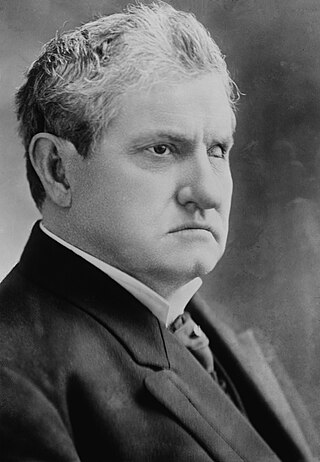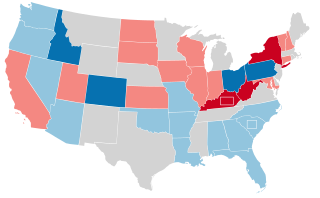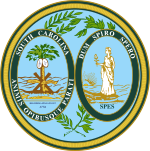
Benjamin Ryan Tillman was a politician of the Democratic Party who served as governor of South Carolina from 1890 to 1894, and as a United States Senator from 1895 until his death in 1918. A white supremacist who opposed civil rights for black Americans, Tillman led a paramilitary group of Red Shirts during South Carolina's violent 1876 election. On the floor of the U.S. Senate, he defended lynching, and frequently ridiculed black Americans in his speeches, boasting of having helped kill them during that campaign.

The 1966 United States Senate elections were elections on November 8, 1966, for the United States Senate which occurred midway through the second term of President Lyndon B. Johnson. The 33 seats of Class 2 were contested in regular elections. Special elections were also held to fill vacancies. With divisions in the Democratic base over the Vietnam War, and with the traditional mid-term advantage of the party not holding the presidency, the Republicans took three Democratic seats, thereby breaking Democrats' 2/3rds supermajority. Despite Republican gains, the balance remained overwhelmingly in favor of the Democrats, who retained a 64–36 majority. Democrats were further reduced to 63–37, following the death of Robert F. Kennedy in June 1968.

The 1956 United States Senate elections were elections for the United States Senate that coincided with the re-election of President Dwight D. Eisenhower. The 32 seats of Class 3 were contested in regular elections, and three special elections were held to fill vacancies. Although Democrats gained two seats in regular elections, the Republicans gained two seats in special elections, leaving the party balance of the chamber unchanged.

United States gubernatorial elections were held on November 5, 2002, in 36 states and two territories. The Republicans won eight seats previously held by the Democrats, as well as the seat previously held by Minnesota governor Jesse Ventura, who was elected on the Reform Party ticket but had since renounced his party affiliation. The Democrats won 10 seats previously held by the Republicans, as well as the seat previously held by Maine governor Angus King, an independent. The elections were held concurrently with the other United States elections of 2002.

The 1924 South Carolina gubernatorial election was held on November 4, 1924, to select the governor of the state of South Carolina. Governor Thomas Gordon McLeod won the Democratic primary and ran unopposed in the general election being reelected for a second two-year term.

The 1882 South Carolina gubernatorial election was held on November 7, 1882 to select the governor of the state of South Carolina. Hugh Smith Thompson was nominated by the Democrats and ran against J. Hendrix McLane, a Greenback-Labor candidate. Thompson easily won the general election and became the 81st governor of South Carolina.

The 1886 South Carolina gubernatorial election was held on November 2, 1886, to select the governor of the state of South Carolina. John Peter Richardson III was nominated by the Democrats and became the 83rd governor of South Carolina.

The 1890 South Carolina gubernatorial election was held on Tuesday November 4, to elect the governor of South Carolina. Ben Tillman was nominated by the Democrats and easily won the general election against A.C. Haskell to become the 84th governor of South Carolina.

The 1892 South Carolina gubernatorial election was held on November 8, 1892, to select the governor of the state of South Carolina. Governor Ben Tillman was renominated by the Democrats and was elected in the general election to a second two-year term.

The 1894 South Carolina gubernatorial election was held on November 6, 1894 to select the governor of the state of South Carolina. John Gary Evans was nominated by the Democrats and became the 85th governor of South Carolina.

The 1896 South Carolina gubernatorial election was held on November 3, 1896 to select the governor of the state of South Carolina. William Haselden Ellerbe won the Democratic primary and easily won the general election to become the 86th governor of South Carolina.

The 1900 South Carolina gubernatorial election was held on November 6, 1900 to select the governor of the state of South Carolina. Governor Miles Benjamin McSweeney won the Democratic primary and ran unopposed in the general election to win a term for governor in his own right.

The 1910 South Carolina gubernatorial election was held on November 8, 1910, to select the governor of the state of South Carolina. Coleman Livingston Blease won the Democratic primary and ran unopposed in the general election to become the 90th governor of South Carolina.
The 1912 South Carolina gubernatorial election was held on November 5, 1912, to select the governor of the state of South Carolina. Governor Coleman Livingston Blease won the Democratic primary. As South Carolina was utterly dominated by the Democratic Party, he faced no significant opposition in the general election.

The 1914 South Carolina gubernatorial election was held on November 3, 1914, to select the governor of the state of South Carolina. Richard Irvine Manning III emerged from the crowded Democratic primary to win in the runoff and overwhelmingly won the effectively one-party state's general election to become the 92nd governor of South Carolina.

The 1916 South Carolina gubernatorial election was held on November 7, 1916, to select the governor of the state of South Carolina. Governor Richard Irvine Manning III faced a strong challenge from former governor Coleman Livingston Blease in the Democratic primary, but Manning won a second two-year term as governor.

The 1918 South Carolina gubernatorial election was held on November 5, 1918, to select the governor of the state of South Carolina. Robert Archer Cooper emerged from the crowded Democratic primary and ran unopposed in the one-party state's general election to become the 93rd governor of South Carolina.

The 1918 South Carolina United States Senate election was held on Tuesday, November 5, simultaneously with the special senate election to elect the United States Senator for a six-year term from South Carolina. Nathaniel B. Dial won the Democratic primary and was unopposed in the general election to win the six-year term to the Senate.

The 1897 South Carolina United States Senate election was a unanimous election of the Democratic nominee on January 26, 1897, to select the U.S. Senator from the state of South Carolina. The Democratic primary election was held on August 26, 1896, and September 9. Prior to the ratification of the 17th Amendment to the United States Constitution, U.S. Senators were elected by the state legislature and not through the direct election by the people of the state. However, the Democratic Party of South Carolina organized primary elections for the U.S. Senate beginning in 1896 and the General Assembly would confirm the choice of the Democratic voters. Conservative Democratic Joseph H. Earle won the Democratic primary and was elected by the General Assembly for a six-year term.

Elections were held in South Carolina on Tuesday, November 2, 2010. Primary elections were held on June 8, 2010, and a run-off election for certain contests was held on June 22, 2010.












